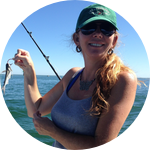
Rhoni A. Lahn
Fairhope, AL
Harvard University
Project Manager
More
My Mum knew I was going to be a Biologist by the time I was 6yrs old. I would go outside and collect every critter I could find and put them in my pockets. She would then have to skim them off the fill cycle of the washing machine. Unfortunately, worms sank and she learned to clean my pockets out before the clothes went into the laundry. I have since quite putting everything in my pockets but my love of nature hasn't diminished. I have worked offshore as both an Endangered Species Observer (ESO) and Protected Species Observer for over 15 years. As an ESO, I took the opportunity to rescue stingrays and skates while aboard dredges. It was a project in the Rio Grande River Texas, that piqued my interest in learning more about the population dynamics of stingrays. How far did they travel up rivers? How long did they stay? Did they breed in brackish waters? What contributes to their population fluctuations? Are fisherman keeping them? I recently started a Natural Resource Management and Sustainability certificate from Harvard University. I feel that I can gain a greater knowledge of what it will take to raise awareness about the integrated role stingrays and skates play in our coastal environments from my continued education.
February 2015
Haven't created any projects yet!
Haven't backed any projects yet!
No lab notes posted yet!